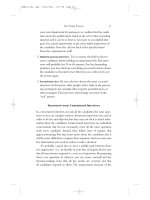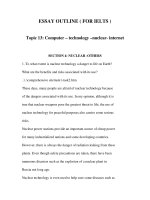clay mineral sandsoi lstructure best topic 4 090427235131 phpapp02
Bạn đang xem bản rút gọn của tài liệu. Xem và tải ngay bản đầy đủ của tài liệu tại đây (6.89 MB, 96 trang )
Clay Minerals and Soil Structure
1
Outline
1.
2.
3.
4.
5.
6.
7.
8.
9.
10.
11.
12.
Clay Minerals
Identification of Clay Minerals
Specific Surface (Ss)
Interaction of Water and Clay Minerals
Interaction of Clay Particles
Soil Structure and Fabric
Soil Fabric-Natural Soil
Soil Fabric-Clay Soils
Soil Fabrics-Granular Soils
Loess
Suggested Homework
References
2
1. Clay Minerals
3
(c)2001 Brooks/Cole, a division of Thomson Learning, Inc. Thomson Learning™ is a trademark used herein under license.
Figure 2.2
Bowen’s reaction
series
Figure 2.3A Mechanical erosion due to ocean
waves and wind at Yehliu, Taiwan
(c)2001 Brooks/Cole, a division of Thomson Learning, Inc. Thomson Learning™ is a trademark used herein under license.
(c)2001 Brooks/Cole, a division of Thomson Learning, Inc. Thomson Learning™ is a trademark used herein under license.
Figure 2.3B (cont.) Mechanical
erosion due to ocean waves and
wind at Yehliu, Taiwan
Figure 2.3C (cont.) Mechanical erosion due to
ocean waves and wind at Yehliu, Taiwan
(c)2001 Brooks/Cole, a division of Thomson Learning, Inc. Thomson Learning™ is a trademark used herein under license.
(c)2001 Brooks/Cole, a division of Thomson Learning, Inc. Thomson Learning™ is a trademark used herein under license.
Figure 2.3 D (cont.)
Mechanical erosion due
to ocean waves and
wind at Yehliu, Taiwan
(c)2001 Brooks/Cole, a division of Thomson Learning, Inc. Thomson Learning™ is a trademark used herein under license.
Figure 2.3E (cont.)
Mechanical erosion due
to ocean waves and
wind at Yehliu, Taiwan
Figure 2.7
Scanning electron
micrograph of a
kaolinite specimen
(courtesy of U.S.
Geological
Survey)
1.1 Origin of Clay Minerals
“The contact of rocks and water produces clays, either at or near the surface
of the earth” (from Velde, 1995).
Rock +Water → Clay
For example,
The CO2 gas can dissolve in water and form carbonic acid, which will
become hydrogen ions H+ and bicarbonate ions, and make water slightly
acidic.
CO2+H2O → H2CO3 → H+ +HCO3The acidic water will react with the rock surfaces and tend to dissolve the K
ion and silica from the feldspar. Finally, the feldspar is transformed into
kaolinite.
Feldspar + hydrogen ions+water → clay (kaolinite) + cations, dissolved silica
2KAlSi3O8+2H+ +H2O → Al2Si2O5(OH)4 + 2K+ +4SiO2
•Note that the hydrogen ion displaces the cations.
11
1.1 Origin of Clay Minerals (Cont.)
•
The alternation of feldspar into kaolinite is very
common in the decomposed granite.
•
The clay minerals are common in the filling materials
of joints and faults (fault gouge, seam) in the rock
mass.
Weak plane!
12
1.2 Basic Unit-Silica Tetrahedra
1 Si
4O
(Si2O10)-4
Replace four
Oxygen with
hydroxyls or
combine with
positive union
Tetrahedron
Hexagonal
hole
Plural: Tetrahedra
(Holtz and Kovacs, 1981)
13
1.2 Basic Unit-Octahedral Sheet
1 Cation
6 O or OH
Gibbsite sheet: Al3+
Al2(OH)6, 2/3 cationic spaces are filled
One OH is surrounded by 2 Al:
Dioctahedral sheet
Different
cations
Brucite sheet: Mg2+
Mg3(OH)6, all cationic spaces
are filled
One OH is surrounded by 3 Mg:
Trioctahedral sheet
(Holtz and Kovacs, 1981)
14
1.2 Basic Unit-Summary
Mitchell, 1993
15
1.3 Synthesis
Mitchell, 1993
Noncrystall
ine clay
-allophane
16
1.4 1:1 Minerals-Kaolinite
Basal spacing is 7.2 Å
layer
• Si4Al4O10(OH)8. Platy shape
• The bonding between layers are van der
Waals forces and hydrogen bonds (strong
bonding).
Trovey, 1971 ( from
Mitchell, 1993)
17 µm
• There is no interlayer swelling
• Width: 0.1~ 4µm, Thickness: 0.05~2 µm
17
1.4 1:1 Minerals-Halloysite
• Si4Al4O10(OH)8·4H2O
• A single layer of water between unit
layers.
• The basal spacing is 10.1 Å for hydrated
halloysite and 7.2 Å for dehydrated
halloysite.
• If the temperature is over 50 °C or the
relative humidity is lower than 50%, the
hydrated halloysite will lose its interlayer
water (Irfan, 1966). Note that this process is
irreversible and will affect the results of
soil classifications (GSD and Atterberg
limits) and compaction tests.
Trovey, 1971 ( from
Mitchell, 1993)
2 µm
• There is no interlayer swelling.
• Tubular shape while it is hydrated.
18
1.5 2:1 Minerals-Montmorillonite
(Theoretical
• Si8Al4O20(OH)4·nH2O
unsubstituted). Film-like shape.
• There is extensive isomorphous
substitution for silicon and aluminum
by other cations, which results in
charge deficiencies of clay particles.
• n·H2O and cations exist between unit
layers, and the basal spacing is from
9.6 Å to ∞ (after swelling).
n·H2O+cations
• The interlayer bonding is by van der
Waals forces and by cations which
balance charge deficiencies (weak
bonding).
• There exists interlayer swelling,
which is very important to
engineering practice (expansive
clay).
5 µm
(Holtz and Kovacs, 1981)
• Width: 1 or 2 µm, Thickness: 10
Å~1/100 width
19
1.5 2:1 Minerals-Illite (mica-like minerals)
• Si8(Al,Mg,
shape.
potassium
Fe)4~6O20(OH)4·(K,H2O)2.
Flaky
• The basic structure is very similar to the mica,
so it is sometimes referred to as hydrous mica.
Illite is the chief constituent in many shales.
K
• Some of the Si4+ in the tetrahedral sheet are
replaced by the Al3+, and some of the Al3+ in
the octahedral sheet are substituted by the Mg2+
or Fe3+. Those are the origins of charge
deficiencies.
• The charge deficiency is balanced by the
potassium ion between layers. Note that the
potassium atom can exactly fit into the
hexagonal hole in the tetrahedral sheet and
form a strong interlayer bonding.
• The basal spacing is fixed at 10 Å in the
presence of polar liquids (no interlayer
swelling).
7.5 µm
Trovey, 1971 ( from
Mitchell, 1993)
• Width: 0.1~ several µm, Thickness: ~ 30 Å
20
1.5 2:1 Minerals-Vermiculite (micalike minerals)
• The octahedral sheet is brucite.
• The basal spacing is from 10 Å to 14
Å.
• It contains exchangeable cations
such as Ca2+ and Mg2+ and two layers
of water within interlayers.
• It can be an excellent insulation
material after dehydrated.
Illite
Vermiculite
Mitchell, 1993
21
Figure 2.6 Diagram of the structures of (a) kaolinite; (b)
illite; (c) montmorillonite
(c)2001 Brooks/Cole, a division of Thomson Learning, Inc. Thomson Learning™ is a trademark used herein under license.
1.6 2:1:1 Minerals-Chlorite
The basal spacing is fixed at 14 Å.
Gibbsite or
brucite
23
(c)2001 Brooks/Cole, a division of Thomson Learning, Inc. Thomson Learning™ is a trademark used herein under license.
Figure 2.8
Atomic structure
of illite
(c)2001 Brooks/Cole, a division of Thomson Learning, Inc. Thomson Learning™ is a trademark used herein under license.
Figure 2.4 (a) Silica
tetrahedron; (b)
silica sheet; (c)
alumina
octahedron; (d)
octahedral
(gibbsite) sheet; (e)
elemental silicagibbsite sheet;
(after Grim, 1959)









